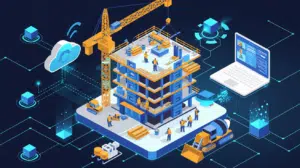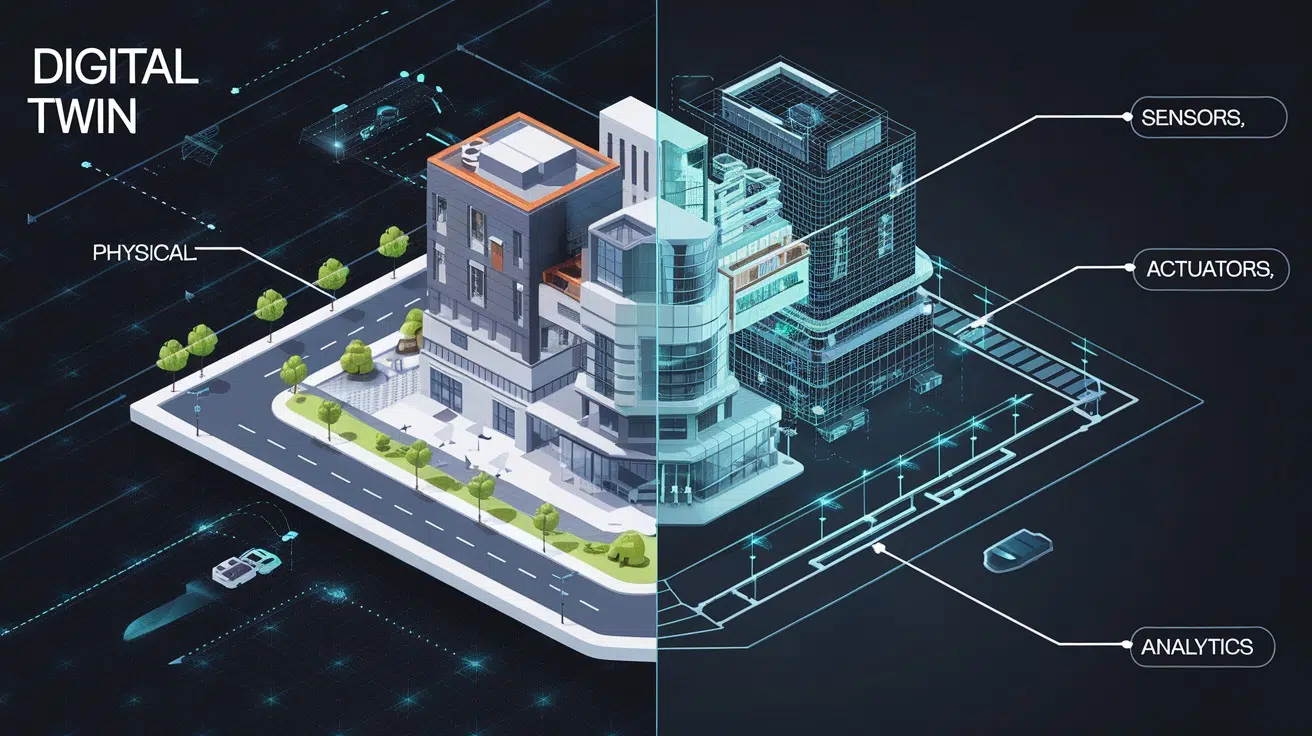The construction industry is changing at lightning speed. If you’re in the AEC space, you’ve probably heard about digital twins—but what does that mean? And more importantly, why should you care?
Imagine having a real-time, virtual replica of your building, one that updates with live data, predicts potential issues, and helps optimize performance at every stage. Sounds like science fiction, right? Well, it’s not!
The concept of digital twins in construction is revolutionizing how we design, construct, and manage buildings, saving time, reducing costs, and making projects more efficient. Stick around, and I’ll walk you through how this game-changing technology works, the benefits it offers, and why it’s set to dominate the future of construction.
What is a digital twins in construction?

A digital twin is a real-time, data-driven virtual replica of a physical building, infrastructure, or system. It goes beyond static 3D models by integrating IoT sensors, real-time data, and AI-driven analytics, allowing for continuous monitoring, simulation, and optimization.
Think of it as a living, breathing digital version of a construction project that helps you understand how your structure is performing before, during, and after construction.
Using technologies like point cloud data, Building Information Modeling, and AI-driven simulations, enables construction professionals to test different scenarios, predict outcomes, and optimize building performance—all without touching the physical asset.
Now, let’s break it down further.
How Digital Twin Works
Here’s a step-by-step breakdown of how digital twins function in construction:
1. Data Collection:
The first step in creating a data twin is gathering data from IoT sensors, drones, LiDAR scanners, and other monitoring devices. These tools capture real-time information such as temperature, humidity, energy consumption, structural stress, and even human occupancy levels.
The more data you collect, the more accurate and responsive your technology becomes. This data acts as the foundation for real-time decision-making and predictive analytics.
2. Data Integration:
Next, all the collected data—whether from BIM models, point cloud data, IoT sensors, or past project insights—is merged into a single digital environment.
This integration enables a holistic view of the project, where architects, engineers, and contractors can see how different systems interact and predict potential conflicts before construction even begins.
3. Real-Time Monitoring:
Once the digital twin is live, it continuously tracks performance, wear and tear, and environmental factors. If there’s an issue—like excessive structural stress or an HVAC system failure—they detect it before it becomes a major problem.
Think of it as an advanced early warning system for your construction project.
4. Simulation & Analysis:
Now, here’s where digital twins shine! By using AI and machine learning, you can run simulations to test how your building will behave under different conditions.
Want to know how your skyscraper will react to extreme winds? Or how energy-efficient your HVAC system is in the winter? The data twin has the answers before you even build.
5. Feedback Loop:
Finally, the insights from the digital twin feed back into ongoing maintenance and future projects. This ensures that buildings are not only constructed better but also maintained smarter, reducing operational costs and increasing efficiency over time.
Benefits of Digital Twins in Construction
Why should you care about digital twins? Here’s what it brings to the table:
- Better Collaboration: Digital twins create a shared digital workspace where all stakeholders, including architects, engineers, and contractors, can access real-time project data. This minimizes miscommunication and ensures better decision-making.
- Data-Driven Decision Making: With real-time analytics, project managers and owners can make informed decisions based on real-world data rather than relying on assumptions. This leads to improved accuracy in cost estimation, scheduling, and resource allocation.
- Cost Savings: Construction projects often suffer from cost overruns due to unforeseen issues. Digital twins allow teams to detect problems early, preventing expensive rework and unexpected costs. Additionally, predictive maintenance helps reduce long-term operational expenses.
- Sustainability & Energy Efficiency: By continuously monitoring energy consumption and environmental factors, digital twins help identify areas where energy efficiency can be improved. This leads to reduced carbon footprints and optimized resource usage in construction and building operations.
- Lifecycle Management: Unlike traditional project management methods, digital twins support the entire lifecycle of a building—from planning and design to construction, operation, and even demolition. This ensures that buildings remain well-maintained and operate at peak efficiency for years to come.
Challenges Digital Twin is Solving
The construction industry faces numerous challenges, many of which digital twins effectively address:
Lack of visibility into real-time project performance Without real-time data, teams rely on outdated reports, leading to delays and misinformed decisions.
Solution: Digital twins provide live project insights, allowing for proactive adjustments and improved efficiency.
Costly rework and project delays Unexpected design errors and construction clashes often result in rework, increasing both time and costs.
Solution: By simulating and analyzing various scenarios beforehand, digital twins help identify and resolve potential issues before they cause disruptions.
Difficulty in predicting maintenance issues: Traditional maintenance approaches are reactive rather than proactive.
Solution: Digital twins enable predictive maintenance by using real-time data to forecast wear and tear, preventing costly failures before they occur.
Disjointed communication between teams: construction projects involve multiple teams working in different locations, leading to information gaps.
Solution: A digital twin centralizes all project data, ensuring that all stakeholders have access to accurate and updated information at all times.
Future of Digital Twins in Construction

The future looks bright for digital twins. According to MarketsandMarkets, the global digital twin market is set to grow from $10.1 billion in 2023 to a staggering $110.1 billion by 2028. That’s a CAGR of 61.3.
As more construction companies adopt IoT sensors, AI-driven analytics, and BIM technology, digital twins will become an industry standard. Future advancements will likely include augmented reality (AR) integrations, deeper AI-driven automation, and even blockchain-based security for data management.
Put, digital twins aren’t just the future—they’re happening now. The sooner you embrace this technology, the further ahead you’ll be.
Conclusion
If you’re in the construction industry, you can’t afford to ignore digital twin technology. It is no longer just an innovative concept—it is transforming the way buildings are designed, constructed, and maintained. Digital twins offer a holistic, data-driven approach that enhances efficiency, reduces risks, and optimizes operational performance.
Integrating digital twins into your workflow gives you a competitive edge through improved collaboration, cost savings, and long-term sustainability. The ability to predict issues before they arise, streamline maintenance, and ensure data-backed decision-making makes this technology invaluable for future-proofing construction projects.
